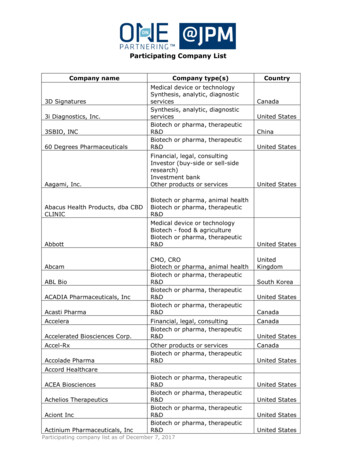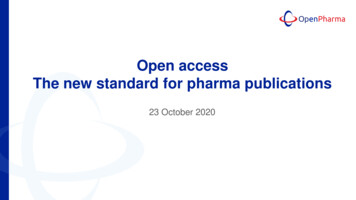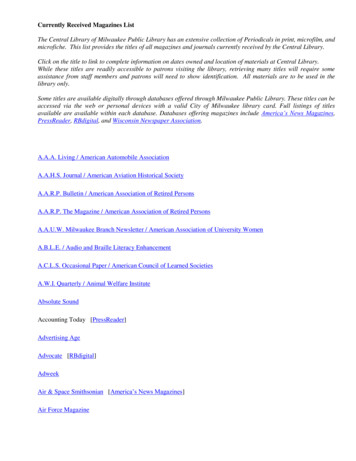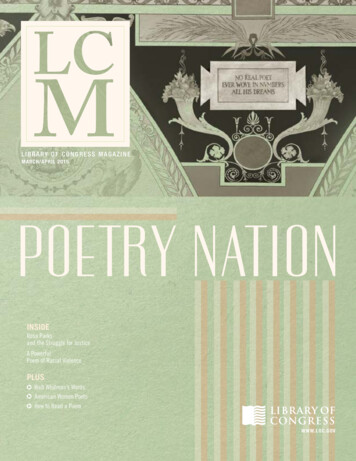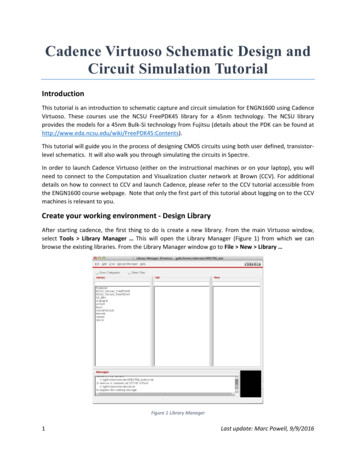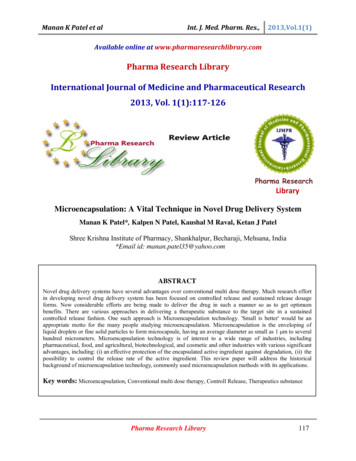
Transcription
Manan K Patel et alInt. J. Med. Pharm. Res.,2013,Vol.1(1)Available online at www.pharmaresearchlibrary.comPharma Research LibraryInternational Journal of Medicine and Pharmaceutical Research2013, Vol. 1(1):117‐126Pharma ResearchLibraryMicroencapsulation: A Vital Technique in Novel Drug Delivery SystemManan K Patel*, Kalpen N Patel, Kaushal M Raval, Ketan J PatelShree Krishna Institute of Pharmacy, Shankhalpur, Becharaji, Mehsana, India*Email id: manan.patel35@yahoo.comABSTRACTNovel drug delivery systems have several advantages over conventional multi dose therapy. Much research effortin developing novel drug delivery system has been focused on controlled release and sustained release dosageforms. Now considerable efforts are being made to deliver the drug in such a manner so as to get optimumbenefits. There are various approaches in delivering a therapeutic substance to the target site in a sustainedcontrolled release fashion. One such approach is Microencapsulation technology. 'Small is better' would be anappropriate motto for the many people studying microencapsulation. Microencapsulation is the enveloping ofliquid droplets or fine solid particles to form microcapsule, having an average diameter as small as 1 μm to severalhundred micrometers. Microencapsulation technology is of interest to a wide range of industries, includingpharmaceutical, food, and agricultural, biotechnological, and cosmetic and other industries with various significantadvantages, including: (i) an effective protection of the encapsulated active ingredient against degradation, (ii) thepossibility to control the release rate of the active ingredient. This review paper will address the historicalbackground of microencapsulation technology, commonly used microencapsulation methods with its applications.Key words: Microencapsulation, Conventional multi dose therapy, Controll Release, Therapeutics substancePharma Research Library117
Manan K Patel et alaInt. J.J Med. Phaarm. on is prrocess of enclosing micron sizzed particles inn a polymeric shells 1. A new technologytwhhere bysmall disccrete solid paarticles or smmall liquid dropletsdare surroundedsannd enclosed byb an intact shell.Microencaapsulation is ussed to modify anda delayed druug release formm pharmaceuticcal dosage formms2.'Small is better'bwould beb an appropriate motto for the many peopple studying microencapsulamation. In its simmplestform, a microcapsulemis a small sphere with a unifform wall arouund it. The materialminside the microcapssule isreferred too as the core, innternal phase, or fill, whereaas the wall is sometimesscalled a shell, coating, or memmbrane.Most microocapsules havee diameters bettween a few miicrometers andd a few millimeeters3.udes Bio-encappsulation whicch is more resttricted to the entrapmenteof a biologically activeMicroencaapsulation inclusubstance (from DNA too entire cell oro group of cellls for examplle) generally to improve its performance and/orb Bungen burgg de Jon and KanK inenhance itss shelf life. Firrstly the microoencapsulation procedure was discovered by1931and whichwwere deal with the preparation of gelatingspheres and use of a gelatin coacerrvation process. Themaximum therapeutic effficacy can be achieved by deliveringdof thet active agennt in the optimmal rate to the target4mside effectse.tissue, thenn causing little toxicity and minimumcreleaase fashion varrious approachhes areTo deliver a therapeutic substance to thhe target site inn a sustained controlledma carriers for drugs. Microsspheres are coonsidered as frree flowing poowdersasused. One is by using microspheresware biodeegradable in naature and they have the particcle size below 2002 μm5.consisting of polymers whichcthe liquids to solidds, changing thhe colloidal annd surface propperties,Microencaapsulation proccess helps for convertingproviding environmental protection andd controlling thet release chaaracteristics of different coateed materials. SeveralSmpackagiing techniques;; however, the uniqueness off microencapsuulationof these prroperties can be attained by macrois the smalllness of the coated particless and their subbsequent use annd adaptation to a wide variiety of dosage formsand not hass been technicaally feasible6.FEATURRES AND MORPHOLMLOGY OF MICROCAPMPSULE:he packaging of small dropletts of liquid or particles with a thin film7. Typically,Tthe lowestlMicroencaapsulation is thparticle sizze of microcappsules is 1μm and the largesst size is 1mm. Microcapsulees consist of a core and a wallw (orshell). Thee configurationn of the core canc be a spheerical or irreguular particle, liiquid-phase suuspended solid,, solidmatrix, disspersed solid annd aggregates ofo solids or liquuid forms8.The morphhology of microocapsules depeends mainly onn the core mateerial and the deeposition proceess of the shell. MononuclearM(core-shell) micrrocapsules conntain the shell aroundathe coree. Pooly-nuclear cappsules have maany cores encloosed within thee shell. MatrixMencapsullation in whichh the core mateerial is distributted homogeneoously into the shellsmaterial. Inn addition to thhese three basicc morphologies, microcapsulles can also be mononuclear with multiple shells,9orr they may formm clusters of microcapsulesm.Fig.1.diifferent types ofo microcapsulees with structuure 2CLASSIIFICATIONN:Microcapsuules can be claassified on threee basic categorries according to their morphhology as followws, MononuclearM Poolynuclear MatrixMtypesMononucleear (core-shell) microcapsulees contain the shell around thet core, whilee polynuclear capsules have manycores encloosed within thhe shell. In maatrix encapsulaation, the coree material is diistributed hommogeneously innto theshell materrial. In addition to these threee basic morphhologies, microocapsules can alsoa be mononnuclear with muultipleshells, or thhey may form clusters of miccrocapsules.PPharmaResearch Libraary118
Manan K Patel et alInt. J. Med. Pharm. Res.,2013,Vol.1(1)Figure2. Morphology of microcapsules: (A) Mononuclear or Continuous core/shell microcapsule (Thies1996); (B) Multinuclear or polynuclear microcapsule (Thies 1996); (C) Matrix microcapsule (Vyas and Khar2002) 10REASONS FOR MICROENCAPSULATION¾¾¾¾¾¾¾¾¾¾¾The primary reason for microencapsulation is found to be either for sustained or prolonged drug release.This technique has been widely used for masking the organoleptic properties like taste and odour of manydrugs and thus improves patient compliance e.g. Paracetamol, nitrofurantoine for masking the bitter taste.Vaporization of many volatile drugs e.g. methyl salicylate and peppermint oil can be prevented bymicroencapsulation.This technique can be used for converting liquid drugs in a free flowing powder.The drugs, which are sensitive to oxygen, moisture or light, can be stabilized by microencapsulation.Incompatibility among the drugs can be prevented by microencapsulation.Alteration in site of absorption can also be achieved by microencapsulation.Toxic chemicals such as insecticides may be microencapsulated to reduce the possibility of sensitization offactorial person.Many drugs have been microencapsulated to reduce toxicity and GI irritation including ferrous sulphateand KCl.Bakan and Anderson were reported that microencapsulated vitamin a palmitate had enhanced stability, asprevent from oxidation.Microencapsulation method has also been employed to prepare intrauterine contraceptive device11.Materials for MicroencapsulationCoating Materials:The material to be coated on the core material should be capable of forming a film that is cohesive with the corematerial, chemically compatible with other materials and nonreactive with the core material .The coating materialsprovide the desired coating Properties such as Strength, flexibility, impermeability, optical properties, and stability.Criteria for selection coating material:That would be depending upon review of existing literature where as practical use of free-film information based onfollowing reasons:1. Cast or free films that prepared by the using casting techniques that will formed a thicker filmmicroencapsulation as compared by using of small particles that will formed a thin microencapsulation;hence its proved that cast films may not be extrapolate to the thin microcapsule coatings.2. The coating properties can be affected by the coating substrate of core material. Hence, the result andclassic free film data depend on the selection of coating material. 6Water soluble resinsGelatinStarchTable 1: Example of coating materials 6Water insoluble resinsWaxes and resinsEthyl teStearicacidStearyl alcoholPharma Research LibraryEnteric resinsShellacCelluloseacetatephalateZein119
Manan K Patel et alInt. J. Med. Pharm. Res.,2013,Vol.1(1)Core Materials:The specific material to be coated by using the specific coating material can be liquid or solid in nature. Thecomposition of the core material can be varied, as the liquid core can include dispersed and/or dissolved materials.The solid core material can be active constituents, stabilizers, diluents, and release-rate inhibitors or accelerators.This variation in the core material composition provides definite flexibility and utilization of this characteristic thenallows effective design and development of the preferred microcapsule properties6.Fig. 3: MicroencapsulationTechniques to Manufacture MicrocapsulesManufacturing techniques of microcapsulesMicrocapsules as bulk materials, in either dry powder or dispersed form, can be processed into final productapplications using common equipment such as V blenders, tablet machines, granulators, homogenizes, kneaders,hard gelatine capsule filling machines, or coating equipment if deposition onto a substrate is desired 7. There aremany factors to consider when selecting the encapsulation process and also various techniques are available for theencapsulation of core materials. Generally, microencapsulation methods are divided into two basic groups, namelychemical and physical, with the latter being further subdivided into physico-chemical and physico-mechanicaltechniques. This article describes the most generally accepted classification of the microencapsulation methodssummarized in Table I. The microencapsulation methods and their applicabilities are given in Table II.Table I: Methods of MicroencapsulationChemical PolymerizationIn-situ Emulsion,Suspension, Dispersion InterfacialpolycondensationPhysico-chemical Coacervation Solvent evaporation,Solvent extraction Layer-by-layer adsorption Complex precipitation Ionic gelation Supercritical Fluid precipitationPhysicalPhysico-mechanical Spray-drying and congealing Electrostatic encapsulation Pan coating Vacuum encapsulation Extrusion Air suspension Multiorifice-centrifugalMicroencapsulation Methods121.2.3.4.5.6.7.Air suspensionCoacervation phase separationMultiorifice-centrifugal processSpray dryingPan coatingSolvent evaporation techniquesPolymerizationPharma Research Library120
Manan K Patel et ala1.2.3.4.Int. J.J Med. Phaarm. Res.,2013,Vol.11(1)Air Suuspension: Thhe air suspensioon technique innvolves the disspersion of thee core materialls in a supportiing airstreamm and the sprayy coating on thhe air suspended particles. Thhe moving air streamssuspendds the particless on anupwarrd within the coating chambeer. The design of the coating chamber and its operating parameterspshould bein such a way that couldceffect thee flow of the particlespthrouggh the coating zone of chambber, where a coatingcolution) is applied to the movving particles.materiial (polymer soAs thhe moving partiicles passed thhrough the coatting zone repeatedly, the corre material receeive more of coatingmateriial. The cyclic process is repeeated aboutseveraal time dependding on the coaating thicknesss desired or whhether the coree material partticles are thorooughlyencapssulated. The enncapsulated prroduct is dried by passing thee stream air. DryingDrates are directly depeendingto the temperature off the supporting air stream. TheT process varriables that cann affect the process- 12Cofo the coating materialmor if inn solution formm then melting point.p Concentration Soolubility, surfaace area, densitty, melting poinnt volatility, voolatility of coree material. ApplicationAratee of coating maaterial. Temperature of air stream.a required to fluidize the corre material. Thhe amount of airCoaceervation Phasse Separation:: This processs of microencaapsulation is generallygreferrred to The NaationalCash RegisterR(NCRR) Corporation and the patentss of B.K. Greenn. This processs consists of thhree steps- 13 Foormation of thhree immisciblee phases; a liqquid manufactuuring phase, a core material phase and a coatingmmaterialphase DepositionDof thhe liquid polymmer coating on the core materrial RigidizingRof the coating mateerialStep-11:The fiirst step of coaacervation phase separation involvesithe foormation of thrree immisciblee chemical phaases: aliquid vehicle phasee, a coating materialmphase and a core materialmphase. The three phhases are formmed bymin a soolution of coatiing polymer, thhe vehicle phasse is used as a solvent for pollymer.disperrsing the core materialThe cooating materiaal phase consissts of a polymmer in a liquid phase, is formmed by using one of the of phaseseparaation- coacervaation method, i.e. .by channging the tempperature of thhe polymer solution, by addding asolutioon, or by induccing a polymer-- polymer interraction. 12Step-22:It invoolves the depoosition of the liquid polymeer coating uponn the core maaterial. This is done by conttrolledmixingg of liquid cooating materiaal and the core material in the manufactuuring vehicle. The liquid coatingcpolymmer deposited ono the core maaterial if the polymerpis adssorbed at the interfaceiformeed between the coremateriial and liquid phase.pThe redduction in the total free interrfacial energy of the system help to promoote thedeposiition of the coatingcmaterial, brought byy the decrease of the coatting material surface area duringd13coalesscence of the liquid polymer droplets.dStep-33:In the last step rigiddizing of the cooating materiall done by the thermal,tcross linking desolvvation techniquues, toforms a self supportiing microcapsuule. 12PPharmaResearch Libraary121
Manan K Patel et alaInt. J.J Med. Phaarm. Res.,2013,Vol.11(1)Figgure: 4: Microoencapsulation by coacervatioon phase separaation process5.6.Multi orifice-Centtrifugal proceess: Microenccapsulation byy the multi orifice-centrifuougal process is themechaanical process in which the centrifugal foorce is appliedd to throw a core material particle throuugh anenvelooping microencapsulation meembrane. The factors affect the Process innclude the rottational speed of thecylindder, the flow raate of the coating and core materialsmand thhe concentratioon, viscosity annd surface tenssion ofthe coore material. ThisTprocess iss capable of producingpthe microencapsulmlation of the liiquids and sollids ofvariedd size ranges, byb applying thhe different cooating materialls. The encapsulated productt can be suppllied asslurry in the hardenning media. Wiith this processs the productiion rate of 50 to 75 pounds per hour havee beenachievved. 12Sprayy–dryingSpray drying serves as a microenccapsulation tecchnique when ana active mateerial is dissolveed or suspendeed in ao polymer soluution and becommes trapped inn the dried partticle. The mainn advantages is the ability to handlehmelt orlabile materials because of the shhort contact timme in the dryyer, in additionn, the operatioon is economiccal. Inmoderrn spray dryerss the viscosity of the solutionns to be sprayeed can be as hiigh as 300mPaa.s. Spray dryinng andspray congealing proocesses are simmilar in that both involve dispersing the core material inn a liquefied coatingcying or introduucing the core--coating mixturre into some environmentalecondition, whhereby,substaance and sprayrelativvely rapid soliddification (andd formation) off the coating is affected. Thee principal diffference between thetwo methodsmis the meansmby whicch coating soliddification is acccomplished. CoatingCsolidifiication in the casecofspray drying is effeccted by rapid evaporationeoff a solvent in whichwthe coatting material is dissolved. Coatingmhoweever, is accompplished by therrmally congealing a molten coatingcsolidiffication in spraay congealing methods,materiial or by soliddifying a disssolved coatingg by introducing the coatingg - core mateerial mixture into anonsollvent. Removaal of the nonsoolvent or solveent from the cooated product is then accommplished by sorrption,extraction, or evaporation techniiques. In pracctice, microenncapsulation byy spray dryinng is conductted bydisperrsing a core maaterial in a coaating solution, in which the coating substaance is dissolvved and in whiich thecore materialmis insooluble, and thenn by atomizingg the mixture into air streamm. The air, usually heated, suuppliesthe lattent heat of vaporizationvreequired to remmove the solveent from the coatingcmateriaal, thus forminng themicroeencapsulated product.pThe equipment coomponents of a standard sppray dryer incclude an air heater,hatomizzer, main spraay chamber, blower or fan, cyclone and productpcollecctor. Microenccapsulation by spraycongeaaling can be acccomplished withw spray dryinng equipment when the proteective coating is applied as a melt.Generral process varriables and coonditions are quiteqsimilar too those alreaddy described, exceptethat thee coremateriial is dispersed in a coatingg material melt rather than a coating sollution. Coatingg solidificationn (andmicroeencapsulation) is accomplishhed by sprayingg the hot mixtuure into a cool air stream. Waxes,Wfatty acidds andalcohools, polymers anda sugars, whhich are solids at room tempperature but meeltable at reasoonable temperaatures,are appplicable to spraay congealing techniques.PPharmaResearch Libraary122
Manan K Patel et al7.8.9.Int. J. Med. Pharm. Res.,2013,Vol.1(1)Typically, the particle size of spray congealed products can be accurately controlled when spray dryingequipment is used, and has been found to be a function of the feed rate, the atomizing wheel velocity, dispersionof feed material viscosity, and variables7.Pan coatingThe pan coating process, widely used in the pharmaceutical industry, is among the oldest industrial proceduresfor forming small, coated particles or tablets. The particles are tumbled in a pan or other device while thecoating material is applied slowly22.The pan coating process, widely used in the pharmaceutical industry, isamong the oldest industrial procedures for forming small, coated particles or tablets. The particles are tumbledin a pan or other device while the coating material is applied slowly with respect to microencapsulation, solidparticles greater than 600 microns in size are generally considered essential for effective coating, and theprocess has been extensively employed for the preparation of controlled - release beads. Medicaments areusually coated onto various spherical substrates such as nonpareil sugar seeds, and then coated with protectivelayers of various polymers.In practice, the coating is applied as a solution, or as an atomized spray, to the desired solid core material in thecoating pans. Usually, to remove the coating solvent, warm air is passed over the coated materials as thecoatings are being applied in the coating pans. In some cases, final solvent removal is accomplished in a dryingoven7.Solvent Evaporation:Solvent evaporation techniques are performed in a liquid manufacturing vehicle (O/W emulsion) which isformed by agitation of two immiscible liquids. In this process microcapsule coating (polymer) is dissolved in avolatile solvent, which is immiscible with the liquid manufacturing vehicle phase. A core material to bemicroencapsulated is dispersed in the coating polymer solution. To obtain the microcapsule of appropriate sizethe core and coating material mixture is dispersed in the liquid manufacturing vehicle phase with agitation. Theagitation of system is constant till the solvent partitions into the aqueous phase and aqueous phase is removedby evaporation. Various process variables that could affect the process of microencapsulation include methodsof forming dispersions, evaporation rate of the solvent for the coating polymer, temperature cycles and agitationrates. Important factors that must be considered when preparing microcapsules by solvent evaporationtechniques include choice of vehicle phase and solvent for the polymer coating, as these choices greatlyinfluence microcapsule properties as well as the choice of solvent recovery techniques .This technique toproduce microcapsules is applicable to liquid and solid core material. Water soluble or water insoluble materialsare used as core materials. A variety of film forming polymers can be used as coating materials. 12Polymerization:Polymerization is a new method of microencapsulation to form protective microcapsule coatings in situ.Microencapsulation by polymerization involved reaction between a core material substance and continuousphase in which the core material is dispersed. In polymerization a liquid or gaseous phase is used as continuousor core material and as a result the polymerization reaction occurs at a liquid-liquid, solid-liquid, Liquid-gas, orsolid-gas interface. 12RELEASE MECHANISMSMechanisms of drug release from microspheres are:1. Degradation controlled monolithic systemThe drug is dissolved in matrix and is distributed uniformly throughout. The drug is strongly attached to thematrix and is released on degradation of the matrix. The diffusion of the drug is slow as compared withdegradation of the matrix 14.2.DiffusionDiffusion is the most common mechanism of drug release (core material) in which the dissolution fluidpenetrates the shell then the core material comes into the contact with the dissolution fluid and leak out throughthe interstitial channels or pores15. Basically, the release of core material depends on (1)the rate of drugdissolution in the dissolution fluid, (2) the rate of penetration of dissolution fluid to the microcapsules and (3)the rate at which the dissolved drug escape from the microcapsule16. The kinetics of such drug release followsHiguchi’s equation17.Q [D/J (2A – ε CS) CS t] ½Here, Q is the amount of drug released per unit area of exposed surface in time t;J is the tortuousity of the capillary system in the wall;Pharma Research Library123
Manan K Patel et alInt. J. Med. Pharm. Res.,2013,Vol.1(1)D is the diffusion coefficient of the solute in the solution;A is the total amount of drug per unit volume;ε is the porosity of the wall of microcapsule;CS is the solubility of drug in permeating dissolution fluid.3. DissolutionThe release rate of drug from the microcapsule depends on the dissolution rate of polymer coat, when the coat issoluble in the dissolution fluid18.The solubility in the dissolution fluid and thickness of coat influence therelease rate.4. OsmosisAnother method of drug release is through osmosis. The essential requirement of osmosis is semi permeablemembrane and in microcapsule polymer coat serve the purpose. As the process progress an osmotic pressure iscreated between the outside and inside membrane of microcapsule which result in release of drug through smallpores.5. ErosionErosion of coat generally occur due to pH or enzymatic hydrolysis and causes drug release with certain coatmaterials like bee’s wax, stearyl alcohol and glyceryl monostearate.19 The drug release from microcapsules hasbecome complicated because of great diversity in physical forms of microcapsules with size, shape andarrangement of the core and coat materials 20,21. The physiochemical properties of core materials like solubility,diffusibility and partition coefficient and of coating materials like variable porosity, thickness and inertnesswhich makes difficult to modelling of drug release. However, based on various studies concerning with therelease characteristics, the following considerations can be made Drug release rate from microcapsules follow the zero order kinetic. Microcapsules of monolithic type have the t1/2 dependant release rate for the first half of the total drugrelease and thereafter turn down exponentially. Microcapsules of monolithic type having large excess of dissolved drug, the release rate are t1/2 dependantthroughout almost the entire drug release. The path travelled by drug is not constant in monolithic capsules;as the drug at the centre travels a large distance than the drug at the surface. Therefore, the release rate inmonolithic capsules generally decreases with time.APPLICATIONSGeneral Application¾¾¾¾¾¾¾¾¾Cell immobilization: In plant cell cultures, Human tissue is turned into bio-artificial organs, in continuousfermentation processes.Beverage productionProtection of molecules from other compounds:Drug delivery: Controlled release delivery systems.Quality and safety in food, agricultural & environmental sectors.Soil inoculation.In textiles: means of imparting finishes.Protection of liquid crystals 22, 23.Most flavouring is volatile; therefore encapsulation of these components extends the shelf-life of productsby retaining within the food flavours that would otherwise evaporate out and be lost. Some ingredients areencapsulated to mask taste, such as nutrients added to fortify a product without compromising the product’sintended taste24.Controlled Release and Sustained Release Dosage Forms Application5, 6¾¾¾¾To mask the bitter taste of drugs like Paracetamol, Nitrofurantoin etc.To reduce gastric and other gastro intestinal (G.I) tract irritations, e.g., sustained release Aspirinpreparations have been reported to cause significantly less G.I. bleeding than conventional preparations.A liquid can be converted to a pseudo-solid for easy handling and storage e.g. eprazinone.Hygroscopic properties of core materials may be reduced by microencapsulation e.g., Sodium chloride.Pharma Research Library124
Manan K Patel et al¾¾¾¾¾Int. J. Med. Pharm. Res.,2013,Vol.1(1)Carbon tetrachloride and a number of other substances have been microencapsulated to reduce their odourand volatility.Microencapsulation has been employed to provide protection to the core materials against atmosphericeffects, e.g., Vitamin-A Palmitate.Separation of incompatible substance has been achieved by encapsulation.Physicochemical evaluation characterization: The characterization of the micro particulate carrier is animportant phenomenon, which helps to design a suitable carrier for the proteins, drug or antigen delivery.These microspheres have different microstructures. These microstructures determine the release and thestability of the carrier25.Sieve analysis: Separation of the microspheres into various size fractions can be determined by using amechanical sieve shaker26.CONCLUSIONThe microencapsulation approach offers a wide variety of opportunities such as protection and masking, reduceddissolution rate, facilitation of handling, and spatial targeting of the active ingredient. This approach facilitatesaccurate delivery of small quantities of potent drugs, reduced drug concentrations at sites other than the target organor tissue and protection of labile compounds before and after administration and prior to appearance at the site ofaction. Microencapsulation system offers potential advantages over the conventional drug delivery systems.Microspheres and microparticales are a unique carrier system for various pharmaceuticals dosage form. Hence,microspheres and microparticales are not only used for controlled release but also for the target delivery of the drugto the specific site in to the body. The microencapsulation approach also beneficial for those drugs which required todissolved in to the intestine not in the stomach. Therefore, this safe and efficient particular system should bedeveloped in 15.N.V.N. Jyothi, M. Prasanna, S. Prabha, P. Seetha Ramaiah, G. Srawan, S.N. Sakarkar, “MicroencapsulationTechniques, Factors Influencing Encapsulation Efficiency: A Review”, The Internet Journal ofNanotechnology, Volume 3 Number 1. DOI: 10.5580/27bb, 2009.Sharma Nupoor, Rathore KS, “A Review on Microencapsulation: A New Multiutility Advanced Technology”,IJARPB, Vol.1 (4):477-489, 2012.Green BK and Schleicher L: US patent, 2800457, CA 1957, 51; 15842d, 13-627, 1957.Jain N K, “Controlled and Novel drug delivery”, CBS Publisher, 236-237, 1997Vyas S P, Khar R K, “Targeted and Controlled drug delivery”, CBS Publisher, 418, 2002Leon, L, Herbert A L, Joseph, LK; “The Theory And Practice Of Industrial Pharmacy”, 3rd edition, VarghesePublishing House, 412-428, 1990.Blair, H.S., Guthrie, J., Law, T. and Turkington, P, “Chitosan and modified chitosan membranes I, preparationand characterisation”, J. App. Poly.Sci, 33: 641-656, 1987.Nack H, “Microencapsulation techniques, application and problems”, J.Soc.Cosmetic Chemists, 21:85-98,1970.Hammad umer, Hemlata Nigam, Asif M, Tamboli, M. Sundara Moorthi Nainar, “Microencapsulation: Process,Techniques and Applications”, International Journal of Research in Pharmaceutical and Biomedical Sciences,Vol. 2 (2), 474-481, 2011.Sanjoy Kumar Das et al, “Microencapsulation Techniques and its Practice”, Int J Pharma SciTech, Vol-6, Issue - 2, 1-23, 2011.James S, “Encyclopedia of Pharmaceutical Technology”, 3rd Edition, 1325-1333.Lachman LA, Liberman HA, Kanig JL, “The Theory and Practice of Industrial Pharmacy” Varghese PublishingHouse, 414-420, 1990.O’Donnell PB, McGinity JW, “Preparation of microspheres by solvent evaporation technique”, Adv Drug DelRev, 28:25-42, 1997.Bansode, SS, Banarjee, SK, Gaikwad, DD, Jadhav, SL, Thorat, RM, “Microencapsulation: A Review”,International Journal of Pha
Manan K Patel et al Int. J. Med. Pharm. Res., 2013,Vol.1(1) Pharma Research Library 117 Available online at www.pharmaresearchlibrary.com. Pharma Research Library International Journal of Medicine and Pharmaceutical Research
